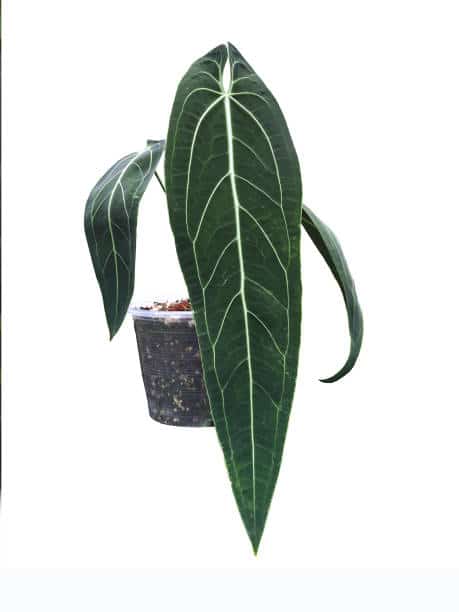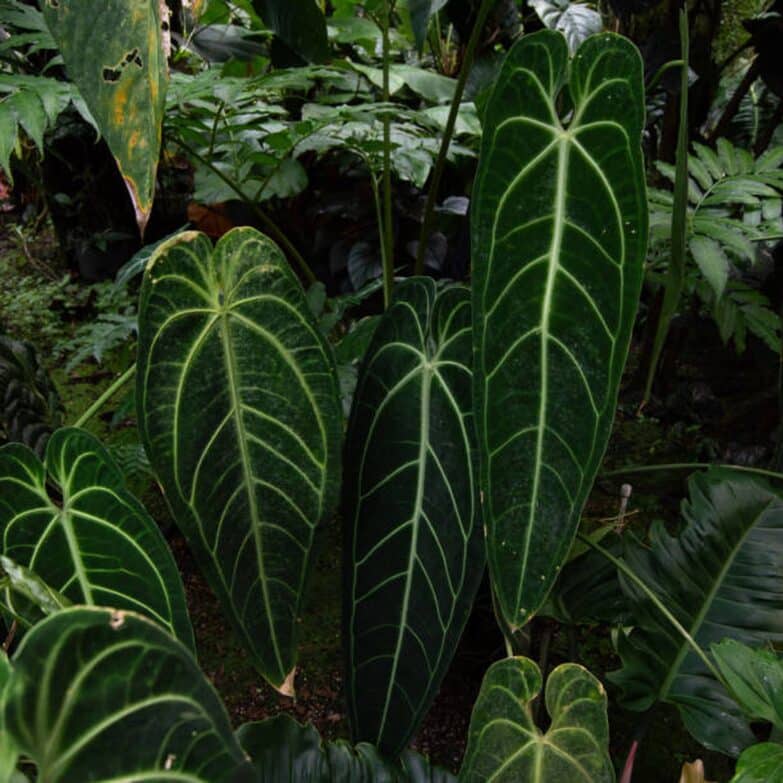Anthurium warocqueanum, commonly referred to as the Queen Anthurium, is a captivating and exotic tropical plant that has captured the hearts of plant enthusiasts and collectors worldwide. With its lush, velvety leaves and striking appearance, this regal species makes a stunning addition to any indoor garden or living space. In this comprehensive guide, we will delve into the fascinating world of Anthurium warocqueanum, exploring its origins, characteristics, care requirements, and tips for successfully cultivating this magnificent plant.
Origins and Natural Habitat
Tracing the Roots of Anthurium Warocqueanum
Anthurium warocqueanum is native to the tropical rainforests of Colombia, where it can be found growing epiphytically on trees or as a terrestrial plant in the dense, humid understory. The species was first described in 1878 by French botanist Édouard André and was named in honor of the Belgian plant collector, M. Warocqué. Since its discovery, the Queen Anthurium has gained popularity among horticulturists and plant enthusiasts for its dramatic foliage and intriguing growth habits.
The Unique Environment of Tropical Rainforests
The natural habitat of Anthurium warocqueanum is characterized by consistently high temperatures, humidity, and ample rainfall. These conditions create a lush, thriving ecosystem where plants like the Queen Anthurium can flourish. In its native environment, Anthurium warocqueanum receives dappled sunlight filtered through the dense rainforest canopy, allowing it to develop its signature large, velvety leaves.
Characteristics of Anthurium Warocqueanum
Enchanting Foliage
The most notable feature of Anthurium warocqueanum is its stunning foliage. The plant’s leaves can grow up to 6.5 feet (2 meters) in length, with a dark green, velvety surface and contrasting silvery veins. These large, oblong leaves gracefully cascade from the plant’s central stem, creating a spectacular visual display.
Inflorescence and Fruit
Although the Queen Anthurium is primarily grown for its foliage, it does produce inflorescences consisting of a green or purple spathe surrounding a cream-colored spadix. These blooms are typically smaller and less showy than those of other Anthurium species. After flowering, the plant may produce small, white fruit containing seeds.
Epiphytic and Climbing Growth Habits
Anthurium warocqueanum exhibits epiphytic and climbing growth habits in its natural habitat, using its aerial roots to anchor itself to trees or other supports. When cultivated indoors, the plant can be grown on a moss pole or another support structure to mimic its natural growth patterns and encourage healthy development.
Cultivating Anthurium Warocqueanum at Home

Light Requirements
To successfully grow Anthurium warocqueanum indoors, it is essential to provide the plant with bright, indirect light. Direct sunlight can scorch the plant’s delicate leaves, causing irreversible damage. A north or east-facing window is an ideal location, or you can use a sheer curtain to filter sunlight in a brighter space.
Temperature and Humidity
As a tropical species, Anthurium warocqueanum thrives in warm, humid conditions. Aim to maintain a consistent temperature between 65-80°F (18-27°C) for optimal growth. Avoid placing the plant near drafty windows or air vents, as sudden temperature fluctuations can stress the plant and cause leaf damage.
To replicate the high humidity levels of the plant’s natural habitat, consider using a humidifier, placing a tray filled with water and pebbles beneath the plant, or grouping it with other humidity-loving plants. Aim for a relative humidity level of at least 60% to keep your Anthurium warocqueanum happy and healthy.
Watering and Fertilization
Anthurium warocqueanum requires consistent moisture but is sensitive to overwatering, which can lead to root rot. Water the plant thoroughly when the top inch (2.5 cm) of soil feels dry to the touch. Be sure to use a well-draining potting mix and a container with drainage holes to prevent waterlogging.
Feed your Anthurium warocqueanum with a balanced, water-soluble fertilizer diluted to half strength every 4-6 weeks during the growing season (spring and summer). Reduce feeding frequency to once every 8-10 weeks during the cooler months. Avoid over-fertilizing, as this can lead to leaf burn and damage the plant’s delicate roots.
Pruning and Training
Regular pruning and training are essential for maintaining the health and appearance of your Anthurium warocqueanum. Remove any yellowing or damaged leaves with clean, sharp scissors or pruning shears. Pruning also encourages bushier growth and prevents the plant from becoming leggy.
As mentioned earlier, Anthurium warocqueanum is a natural climber. To encourage healthy growth and mimic its natural habitat, provide a moss pole or another support structure for the plant to climb. Attach the plant to the support using soft plant ties, and gently train it upwards as it grows.
Common Pests and Diseases
Pests
Like most indoor plants, Anthurium warocqueanum can be susceptible to pests such as mealybugs, spider mites, and aphids. Regularly inspect your plant for signs of infestation and treat any pests promptly to prevent damage. Insecticidal soap or neem oil can be effective treatments for most common pests.
Diseases
Anthurium warocqueanum is relatively resistant to diseases when provided with proper care. However, overwatering or poor ventilation can lead to fungal diseases such as root rot or leaf spot. Ensure your plant is potted in a well-draining mix, avoid overwatering, and provide adequate air circulation to minimize the risk of disease.
Propagation Techniques
Stem Cuttings
Anthurium warocqueanum can be propagated by stem cuttings. To take a cutting, choose a healthy, mature stem with at least one leaf and aerial root. Using a clean, sharp knife or scissors, make a diagonal cut just below the aerial root. Dip the cut end in rooting hormone (optional) and place it in a small container filled with moist, well-draining potting mix or sphagnum moss. Keep the cutting in a warm, humid environment with bright, indirect light, and maintain consistent moisture until roots develop. Once the cutting has established a robust root system, transplant it into a larger pot.
Division
Another propagation method for Anthurium warocqueanum is division. This technique involves separating a mature plant into smaller sections, each with its roots and foliage. Gently remove the plant from its container and carefully separate the root ball, ensuring that each division has a healthy root system and at least one leaf. Plant each division in a well-draining potting mix and provide the same care conditions as a mature plant.
Conclusion
Anthurium warocqueanum, known as the Queen Anthurium, is a captivating tropical plant that adds regal elegance to indoor spaces with its mesmerizing velvety foliage and dramatic growth habits. Understanding its origins, characteristics, and care requirements allows you to successfully cultivate this majestic plant in your home or indoor garden. Although it may demand more attention than some houseplants, the rewards of nurturing this stunning species are well worth the effort. As you care for your Queen Anthurium, its lush beauty transforms your living space into a verdant, tropical oasis, allowing you to embrace its alluring charm and experience the satisfaction of nurturing a truly exceptional indoor garden specimen.

